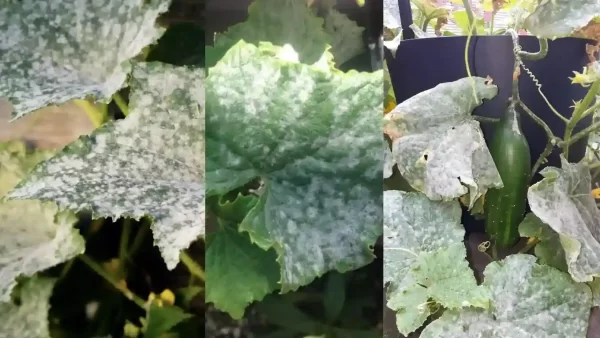How Trichoderma harzianum Helps Control Fusarium Wilt and Powdery Mildew in Cucumbers

The commercial importance of cucumber production remains substantial due to combined factors of consumer preference and nutritional content along with palatable flavor. As a fundamental agricultural product cucumbers endure multiple serious disease infections which threaten their productive capacity. The duo of crop-damaging diseases which affects cucumber growers includes Fusarium wilt and powdery mildew. The pathogen attacks cucumber plants through two destructive diseases which lower harvest quantities while damaging fruit quality and producing severe economic results. Scientists now demonstrate that Trichoderma products function as an effective sustainable biological control agent which efficiently fights these disease-causing pathogens.
The Disease Threat: Fusarium Wilt and Powdery Mildew
The fungal disease Fusarium wilt enters cucumber plants through their vascular system because of Fusarium oxysporum species infection in the soil. The plant disease manifestation includes yellowing along with growth stunting followed by wilting which leads to the final collapse of infected plants. The pathogenic fungal spores survive long periods in soil and make crop rotation ineffective for their removal.
The fungal disease known as powdery mildew develops best in situations with warm dry climates where it reaches the air. All plant parts including leaves and stems and fruits develop white powdery patches which multiply until they become extensive coverings of the affected areas. The fungal growth interrupts photosynthesis as it blocks sun exposure which eventually leads to plant deterioration together with yield reduction.
Trichoderma harzianum: Nature’s Ally in Crop Protection
Trichoderma harzianum exists naturally in the soil where it has developed international acclaim as a biological fungicide organism. Trichoderma harzianum employs various defensive mechanisms which distinguish it from chemical fungicide because they activate three distinct protective measures.
- Trichoderma harzianum effectively claims space and nutrients away from harmful fungi in the rhizosphere thus blocking nosocomial entry of these pathogens.
- Trichoderma conducts mycoparasitism through its destructive action where it envelopes enemy fungus and produces enzymes which break down fungal wall structures.
- The introduction of Trichoderma causes the plant immune system to become more alert and produces faster stronger responses to potential future infections.
- Trichoderma harzianum functions as both a defensive agent and a growth enhancer because of these multiple protective mechanisms.
Introducing Trianum Shield and Trianum-V by Novobac
Novobac provides cucumber farmers with two biological solutions through Trianum Shield while offering Trianum-V as another option. These products contain Trichoderma harzianum as their active ingredient to combat diseases which appear both in soil and on plant leaves.
Trianum Shield functions as a soil-applied fungicide trichoderma predominantly meant to fight Fusarium wilt diseases in plants. The substance incorporates the planting period to form a defensive root boundary that fights pathogens while enhancing root vitality. The product helps plants absorb more water and nutrients which results in superior development.
Trianum-V: Developed as a foliar spray, Trianum-V targets above-ground threats such as powdery mildew. The leaf surface treatment with good microbes prevents pathogens from entering and triggers plants to develop defense mechanisms against disease spread. Its wide range of application makes Trianum-V suitable for both disease prevention and initial treatment of powdery mildew outbreaks.
Recommended Application Guidelines
Cucumber growers should use the established application steps to achieve their best outcomes.
- Growers should apply Trianum Shield at 3 kg per acre during the transplanted seed or seed sowing operation. A second application of Trianum Shield should be scheduled 10-12 weeks after its initial application to maintain extended protection.
- The diluted ratio of Trianum-V requires mixing 2–3 grams into a liter of water solution for covering all sides of both the upper and lower leaf surfaces. The application period should span 7-10 days both before an infection risk period and during its onset.
- These products function properly with mainstream pest and disease management instruments alongside protecting pollinators as well as other beneficial insects.
Benefits Beyond Disease Control
- The use of Trichoderma harzianum-based products produces various advantages for cucumber farmers in their fields.
- The use of Trichoderma harzianum supports sustainable agriculture by eliminating organic farmers’ dependence on synthetic fungicides in their practices.
- The practice of Resistance Management prevents the development of pathogen resistance that commonly arises when fungicides are used repeatedly.
The better nutrient absorption of T. harzianum strengthens plant health while enhancing stress resistance to deliver healthier plants and higher production.
Conclusion: A Smarter Path to Healthy Cucumber Crops
The cucumber growing industry can find an innovative solution for sustainability through the adoption of Trichoderma harzianum biological control agents. The agricultural market obtains dependable science-based treatments for powdery mildew through Trianum-V containing trichoderma for plants, and Fusarium wilt management through Trianum Shield. Utilization of these tools safeguards crops from principal diseases while enhancing soil conditions and minimizing chemical requirements in addition to promoting sustainable operations in the long run.




